The Desert - a filming survival guide
As with all extreme locations, preparation and planning before an expedition is crucial. Choosing the format you wish to film on may be governed by an existing edit suite facility at the production company but this may not be the right choice to deal with high temperatures, difficult access points for filming or just realistic logistics of moving through the desert by vehicle, on foot or even with the trusty but often very grumpy camel.
Technical survival
When planning a filming expedition, I always try to get a wish list of footage from the director and producer which helps guide my choices and recommendations for what kit we will need.
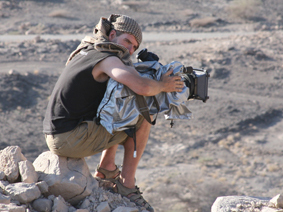 When I was asked to be the DoP for The Hottest Place on Earth for BBC/Discovery, the series director and producer, Rupert Smith, told me the biggest challenge would be to film very close to an active lava lake high up on a volcano.
When I was asked to be the DoP for The Hottest Place on Earth for BBC/Discovery, the series director and producer, Rupert Smith, told me the biggest challenge would be to film very close to an active lava lake high up on a volcano.
The production was busy finding the appropriate volcano protective suits for those nearest the lava, but the big question for me was how and what to film it on.
Sony was to about to release its new EX1 camera that was one of the first HD solid-state small cameras to be hitting the market. Its size, image reproduction quality and above all the solid state recording meant it was ideal for the task ahead. In extreme heat tape cameras can suffer from tape stretch, hence no rewinding in extreme heat to avoid tape fold and jam.
It’s also worth labelling tapes or discs after you have shot the rushes and ejected from the camera. The glue on the labels has a tendency to melt and loosen them that in turn can cause a jam. All things you want to avoid in a remote location. This is another great reason for always having a spare camera body on your kit list.
Technical difficulties or logistics are not the only reason to have a smaller format camera available. Many cultures around the world have little experience of a TV crew and the intimidating sight of a large camera and sound boom being swung overhead can often mean a very nervous contributor who can’t deliver the content you are so keen to get.
Take what time you can afford to gently introduce you and your team to the scene in question. Every production has a budget clock ticking loudly in the ears of every PD but ‘warm up time’ with your contributor is time well spent. Once they are relaxed, they will deliver more than you ask for and the final result will be that much better.
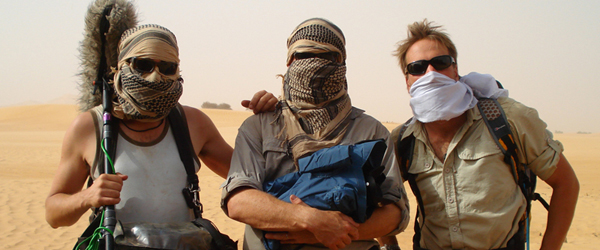 The Afar people of northern Ethiopia are typical of a strict society, which draws a strong divide between men and women. The women sadly are treated as second-class citizens but you must respect the culture you are in and work carefully to avoid upsetting the balance. You may not agree with what you see but you have come as an observer and you must not forget that.
The Afar people of northern Ethiopia are typical of a strict society, which draws a strong divide between men and women. The women sadly are treated as second-class citizens but you must respect the culture you are in and work carefully to avoid upsetting the balance. You may not agree with what you see but you have come as an observer and you must not forget that.
Throughout the planning process of your desert expedition you will soon be building a list of filming challenges and also a clearer idea of how you will be transported throughout the trip. Your transport will dictate how much kit you can take and also how you pack it.
The desert presents many issues for technical equipment. Your main enemies are sand and heat.
Before every expedition I always insist on a full kit check by all the crew involved on the trip. You can’t complain about something missing or not working if you have checked it yourself. You are unlikely to have someone pack your personal bag and your kit should be treated the same. This does not mean the kit hire company is not doing its job but more a belt and braces approach to preparation. When there are multiple crews each set of kit is clearly separated and colour-coded. Each crew is then responsible for their set of kit, which helps to divide up the responsibility between everyone and not just the camera assistant.
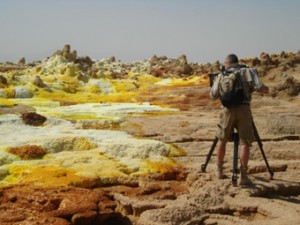 The desert presents many issues for technical equipment. Your main enemies are sand and heat. However, thanks to the recent advances in camera technology, including disc (such as XDCAM) and solid-state cameras, they can now handle the heat far more than any tape camera.
The desert presents many issues for technical equipment. Your main enemies are sand and heat. However, thanks to the recent advances in camera technology, including disc (such as XDCAM) and solid-state cameras, they can now handle the heat far more than any tape camera.
Storage of tapes, discs, SD cards and download external drives must however be carefully managed and kept secure from the elements in a waterproof, dust-free case.
Sand will destroy a camera or at least jam the lens should you be unlucky enough to get caught by wind blowing the sand past you. Always carry a simple paintbrush with you to help dust of the kit. Compressed air can worsen the problem by pushing the sand further in; the cans will also be hot and possibly unsafe.
I always carry a 70-litre dry bag in all environments. This is lightweight and can act as a quick shelter for your main kit. A sand storm can arrive at any time, blocking out the sun, destroying your kit and making life very difficult for you to work in. This happened to me in the Sahara in Libya. I noticed the horizon disappearing in some kind of cloud and soon realised what was heading our way. I then raced to pack my gear and get those around me ready with goggles, something to cover their mouths like a Shermagh and basically group together. My urgency to do this was met with some confusion but within five minutes the sand storm that can move at an alarming rate across the desert had arrived and swallowed us up. It then continued for a further 36 hours!
Of course this makes for a great story and rather than trash the larger camera the trusted smaller format camera was pulled out with its rain cover to try and protect it. The smaller format cameras often have less complicated lenses with fewer parts to jam and they often survive. Having a camera that can also film in night vision is very useful, as the sun disappears fairly rapidly. This situation was all about content and the slight drop in image quality was forgiven thanks to the great story unfolding before us.
Personal Survival
Personal fitness and experience to cope with the desert is a vital aspect to your success and hopefully enjoyment of this amazing environment. The human body can acclimatise within seven days on average as long as you take care to drink plenty of water, eat well and basically look after yourself.
All members of the expedition are responsible for their personal health and washing your hands before eating, plus staying hydrated, are basic but essential habits to be in throughout your trip. Accidents and illness can of course occur but minimising your risks is always the best option. The Hottest Place on Earth production took us to the Danakil Depression. This has the highest average temperatures of anywhere in the world with daily temperatures as high as 56 degrees Celsius and only dropping to 35 at night.
An extreme environment deserves respect. Planning, training and preparation for all eventualities will mean you and your team have a greater chance of success.
Always check the insurance cover that has been purchased on your behalf. Does it cover an emergency medevac back to the UK? Make sure you read it. This could mean the difference between ending up in a foreign hospital or being returned to the UK for emergency surgery within 24 hours. Sounds dramatic, but having seen it happen I now always check.
Personal kit choice is always important. No denim in the desert! There is lots of lightweight clothing that will keep you protected from the sun. Best to have it fairly loose-fitting to allow the air to get to you.
I always wear a water bladder backpack so I have continual easy access to water whilst filming. Working in teams is a great way to have the buddy buddy system to make sure you all keep a wary eye on each other and remind to drink water.
An extreme environment deserves respect. Planning, training and preparation for all eventualities will mean you and your team have a greater chance of success and hopefully an enjoyable experience you’ll never forget.
It is a privilege to visit these places and always worth reminding yourself that 95% of the people you know may never have the opportunity you have to be there. As always it is essential to work as a team during and after filming and to keep communicating with each other, but above all take a moment to absorb the experience and enjoy it!
Related Posts
- The Arctic – a filming survival guide
- Filming on location in Africa – be prepared to be unprepared
- The Canyons – a filming survival guide
- Filming on location: Mountain Water Safety Specialists
- Wildlife filming: What producers should know
- Aerial filming in the UK
- Fixing it up in Southern Spain
- Filming in Bolivia with the Benavides family
Related posts:
Comments
Not Logged in
You must be logged in to post a comment
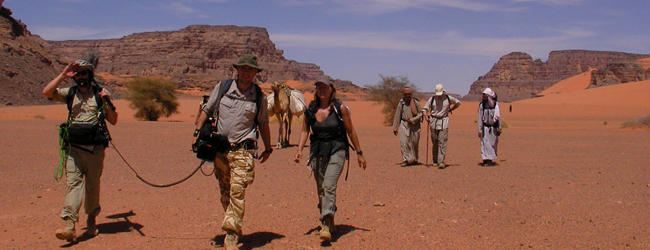
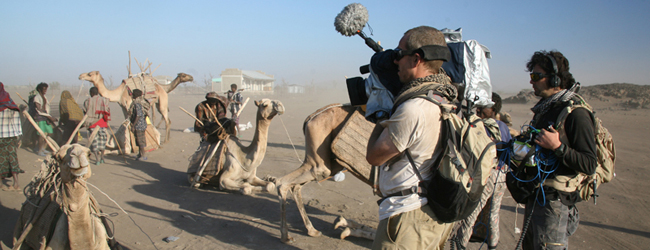
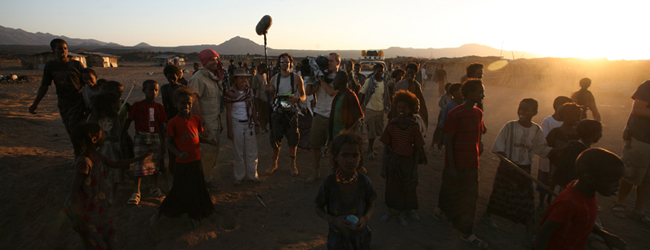
There are 8 comments
MOHAMMED ( GABAAH ) NAWAFLEH
| #
hello from filming in jordan
www.filminginjordan.com
you can cam too jordan too filming her
i will help you in jordan
mohammed gabaah
+962 795 165 895
Reply
Firew Ayele
| #
Dear Richard, How are you ? I am Firew Ayele who was the guide with you on this documentary. It is nice to see you saharing our experience on the Location Guide. I think, in my part, The Hottest Place on Eart is the biggest joib I made in my life. Staying a month in 52 degre tempature is unthinkable.
I am still travelling to the Danakil my maximum stay there is only 5 days. When I tell my tourists about our stay for a month, no one beleive.
Any ways we did it because of the creews strong mentality, management, cooperativeness.
I wish to do the same job again with you and your crew. By the way Erat Ale volcano is now in a diffrent situatuion. the base of the volcano Lake is all boiling now. The dry part on which we managed to land is no more exsist. all is boling. With out a mask, you can not even stand on the rim of the volcano.
Cheers Richard and all friends of the crew.
Reply